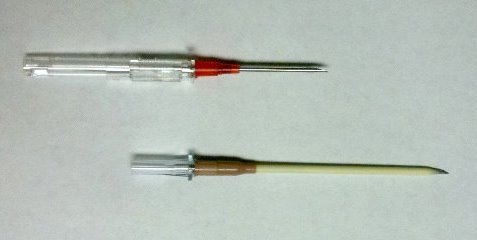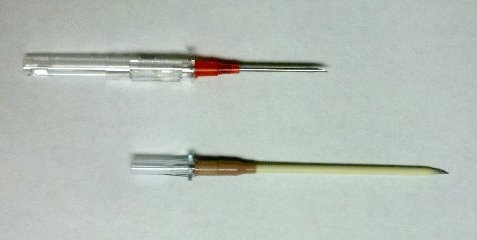
Category Archives: General
More On The “Passing” Of The Rectal Exam
I’ve gotten quite a few comments on my recent post on the “passing” of the rectal exam. One theme has come up that I want to clarify: proper position. Both yours and the patient’s, to be specific.
Precordial Thump commented:
“I have concerns about performing the rectal exam with the patient supine in frog leg position if a pelvic fracture is present. Any further comment?”
This was in regards to my opinion about the proper postion, noted at the very end of my post. Unfortunately, it was a bit too simplistic. As noted, the exam should be performed while the patient is supine, and not on their side, in order to reduce unexpected movement on their part.
The legs have to be moved apart somewhat, because it’s very important to examine the perirectal area before placing a finger. On occasion, blood from elsewhere (IV stick gone wild, bloody clothing) has contaminated the area. If the examiner just blindly inserts a finger and it comes back bloody due to contamination, they have just created a need for some additional, unnecessary diagnostic tests. If the area is bloody before the exam, take a moment to wipe it clean.
There are two ways to get the needed exposure. One thigh can be gently abducted enough to see the perineum. However, most ED carts are not very wide, so the amount of movement allowed is usually small. I usually find it necessary to slightly flex the hip and externally rotate it (half frog-leg), but only enough for exposure. Hopefully you would have detected any significant pelvic fractures with your physical exam before this point, and can plan the rectal exam accordingly.
My final comment deals with examiner position, which nobody ever talks about. One common error I see is that the wrong hand/wrong side problem. People do their best exam with their dominant hand. But if they’re on the wrong side of the patient, they turn at all kinds of angles to try to do it. I call it the “reverse english” exam (billiard reference). The ideal way is to stand next to the patient, looking toward their head, with your dominant hand next to them. Reach across and move their thigh with your nondominant hand, and examine with the dominant. So if you’re right handed, stand on their right side and use your right hand to do the exam.
Related post:
Advanced Needle Thoracostomy
I’ve recently written about the merits of needle vs finger thoracostomy. One of the arguments against needle thoracostomy is that it may not reach into the chest cavity in obese patients. As I mentioned yesterday, use the right needle!

Obviously, the one on top isn’t going to get you very far. The bottom one (10 gauge 3 inch) should get into most pleural spaces.
But what if you don’t have the right needle? Or what if the patient is massively obese and the longer needle won’t even reach? Pushing harder may seem logical, but it doesn’t work. You might be able to get the needle to reach to the pleural space, but the catheter won’t stay in it.
Here’s the trick. First, make the angiocatheter longer by hooking it up to a small (5 or 10cc) syringe. Now prep the chest over your location of choice (2nd intercostal space, mid-clavicular line or 5th intercostal space, anterior axillary line) and make a skin incision slightly larger than the diameter of the syringe. Now place the syringe and attached needle into the chest via your incision. It is guaranteed to reach the pleura, because you can now get the hub of the catheter down to the level of the ribs. Just don’t forget to pull out the catheter once you’ve placed the chest tube!
Related posts:
Why I Don’t Like Finger Thoracostomy
I continue to see interest in using finger thoracostomy in place of needling the chest for the management of real or presumed tension pneumothorax. As noted in the title, I don’t really care for this procedure. I know that there’s a lot of opinion on this topic out there, especially in blogs. My colleague, Scott Weingart (EMCrit) has a very nice podcast on the topic (link below). But the actual scientific literature supporting or condemning its use is sparse.
The procedure consists of doing a limited prep of the chest in the same location for regular chest tube placement, incision, rapid puncture of the parietal pleura, followed by placement of a finger into the pleural space to release tension. Sounds well and good! So what’s my beef? The arguments for it emphasize speed, certainty, and reversibility.
Let’s talk about speed first. This procedure is supposed to be fast. An incision, a few quick sweeps with a clamp, and voila! Finger inserted. And it can be this fast. But in reality, especially in training centers, people who don’t insert chest tubes very often take too long (1-2 minutes).
The next argument is certainty. There are a number of papers showing that needle thoracostomies often miss the mark, especially when using standard through the catheter needles. This is more likely to occur when the needle is inserted in the standard location (2nd intercostal space, midclavicular line) and in obese patients. My response is, use a longer needle!

The angio-catheter on top is a standard 14Ga 1.25 inch model, and won’t get you anywhere. It’s only good for thin people, and will kink as soon as the needle is withdrawn. The bottom model is 10Ga 3 inch, and is effective in everyone save the very morbidly obese. It’s thick and will not kink until it gets good and warm.
The final issue is reversibility. The argument goes, stick a needle in the lung and you’ll get a pneumothorax, but stick a finger in the chest and no harm done. I don’t completely buy this. Puncturing the lung does not a guarantee a pneumothorax. But it will require a subsequent chest xray to see if one develops. Finger thoracostomy doesn’t guarantee that a pneumothorax won’t occur. It also requires a chest xray later to check.
Bottom line: As you can tell, I’m not a big fan of finger thoracostomy, mainly due to speed (or lack thereof). Just stock some big fat needle catheters in your trauma bay and be done with it. But if you really, really want to use the finger technique, make sure that the person doing it is very experienced. This is not a learner’s procedure. It should take no more than 15 seconds, or the wrong person is doing it.
Related posts:
The Passing Of The Rectal Exam In Trauma
It has long been standard operating procedure to perform a digital rectal exam in all major trauma patients. The belief has always been that valuable information about blood in the GI tract, the status of the urethra, and the neuro exam (rectal tone) could be gleaned from the exam.
Unfortunately, the exam also serves to antagonize or even further traumatize some patients, especially those who may be intoxicated to some degree. On a number of occasions I have seen calm patients become so agitated by the rectal that they required intubation for control.
So is it really necessary? A study in 2001 conducted over a 6 month period (1) showed that the rectal exam influenced management in only 1.2% of cases. The authors felt that there was some utility in 3 special cases:
- Spinal cord injury – looking for sacral sparing
- Pelvic fracture – looking for bone shards protruding into the rectum
- Penetrating abdominal trauma – looking for gross blood
A more recent 2005 study (2) was also critical of the rectal exam and found that using “other clinical indicators” (physical exam and other diagnostic study information) was at least equivalent, changing management only 4% of the time. They concurred with the first two indications above as well.
The Bottom Line: For most major trauma patients, the rectal exam is not worth the patient aggravation it causes. I still recommend it for the 3 special cases listed above, however, as there are no equivalent exams for these potentially serious patient problems. And remember, DON’T do it while the patient is in the logroll position. No patient likes a rectal exam, so they’ll do their best to defeat your attempt at spine precautions if you have them on their side. Supine, frog-leg only.
References:
1. Porter, Urcic. Am Surg. 2001 May;67(5):438-41.
2. Esposito et al. J Trauma. 2005 Dec;59(6):1314-9.

